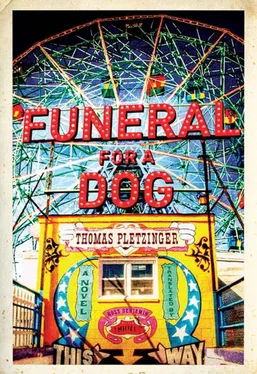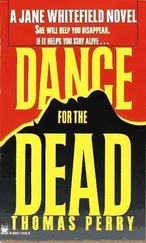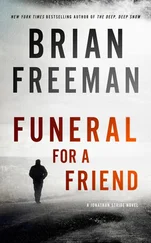my morbid idyll
The reader at the tower window, the vines are reclaiming the stones, an animal is dying, the chickens are strolling around the ruin (Romanticism). For a 3,000-word author profile, that won’t be enough. I lack the starting point for a story (about the writer in the ivory tower there’s nothing plausible left to be said), I think of Malinowski: “In this type of work, it is good for the ethnographer to put aside camera, notebook and pencil, and to join himself in what is going on.” So I put aside the pen to finally speak with Svensson.
Lua’s threat
So early in the morning the air is already warmer than yesterday in Hamburg. From a small balcony high above the ground, a much too narrow and much too steep wooden staircase leads down along the wall of the house (three steps are missing), swallows and pigeons are fluttering in the exposed gables, wasps are buzzing around my head. As I walk down to the dock, Lua lifts his head and looks at me. On the lake drift flowers, leaves, plastic bottles (the lake a stained mirror). It must be eight o’clock now, I think for a few unexpected seconds of Elisabeth (under the lindens in front of our house she’s searching for her key; Svensson’s ruin lies like a garbage bag ready for collection next to the Asian take-out place on the ground floor of 88 Bismarckstrasse). The noise of the wasps and the gurgle of the water are sounds that make you lonely, I would miss the breathing of the city here (the first buses, the first S-Bahn). Is anyone here? I ask. The two fishermen now row past me farther away from the shore, I raise my hand, but they don’t return the greeting (I don’t belong here). I walk very slowly and in a cautious curve back to the house, Lua’s eyes follow me. Then the old dog suddenly sits up and barks at me threateningly and darkly, as if I were an intruder (as if I were getting too close to his secret). Tuuli? I ask, Svensson? Nothing. I’m alone with the three-legged dog.
museum
Svensson lives in the front and intact part of the narrow house, in the back wild vine and ivy are growing in through the windows and the cracked roof. The rusty door of the shed is locked, in front of it are the circular saw, the stack of plastic pipes, and a toolbox (green and yellow). The grass has grown high, even though there’s a lawn mower resting in the middle of the meadow. The ground floor with a fireplace and floor-length windows facing the lake, stone steps are set in the wall on the left (without railing), a gallery runs along three sides of the room, above is the entrance to the sparse kitchen. Svensson’s house is Svensson’s museum. It’s now light enough to view the pictures on the walls. I recognize the drawings from The Story of Leo and the Notmuch (I walk through Svensson’s book). On the ground floor several portraits are hanging on the unplastered walls, oil on canvas, almost always showing Svensson in urban scenes, subway signs maybe, the Chrysler Building probably (New York). Settings and backgrounds fray at the edges, undercoats show through, sometimes the canvas too. On the other hand: Svensson’s face is always clear and distinct, his eyes don’t smile, his gaze bores directly into the viewer (can a painter look at himself this way?). I walk from painting to painting: Svensson in a suit in front of a take-out place in Chinatown (maybe), in the background hang chickens (naked and iodine-yellow, headfirst), Svensson naked on a bed against a splotchy green background without perspective, Svensson and Lua on steps. In the right lower corner of most of the paintings, two black letters (another pseudonym?):
k; k;
Finally, on the wall above the wooden table, a painting of Svensson on his Italian dock, some fleeting rings in the water, otherwise it’s dark. Svensson is holding a hand in the air, in the darkness on the opposite shore a yellow light, on the lower edge in the same yellow
THE GREAT SVENSSON
(Can he be serious?)
She offered herself to me
An afternoon in August 2003: Elisabeth and I on our bikes on the way back from the Kaifu-Bad swimming pools. First we’d talked about this and that, then very theoretically about sex, about the individual body in a visual society, all day we’d lain side by side on a towel, the pool full of children’s noise, piked somersaults, beer cans and cigarettes in the wet fingers of thin sixteen-year-old girls. Back in my apartment we left the bikes unlocked in front of the building (Marthastrasse), the clammy beach bag lay next to the dresser. Elisabeth held on to my pull-up bar with one hand, I buried my face in the scanty flesh of her stretched shoulder, reached for her surprisingly large breasts (in comparison) and Elisabeth threw her red bikini bottom on the living room floorboards. Dust hung in the room. I never told you that I’m married, said Elisabeth, arching her back (she offered herself to me).
Could she be serious?
I’m standing in the dark stairwell. Is no one here? The door to what seems to be Svensson’s bedroom is wide open: a small room, a bed (white sheets, two pillows), next to it a blue and yellow baby changing table. In an open closet shirts wrapped in plastic, folded towels, suits, shorts, T-shirts ( Lavasecco Sole — Lavanderia & Stireria ). Some hangers with black dresses and skirts in bright colors, women’s underwear and flip-flops. Then: a box of diapers (Pampers, Italian packaging). A baby changing table and diapers? The passing thought once again that Svensson must have been waiting for Tuuli and the boy, that he’s the boy’s father, that he got everything ready. An airplane mobile? A stuffed mouse?
What’s all this about?
The kitchen window is open, the pots are neatly stacked, dappled sunlight on the floor, Lua’s bowl in the corner (this museum is inhabited). At the head of the table a high chair for a toddler (the boy is too big for this chair). The walls are covered with framed photos, smaller canvases, thumbtacked sketches, here too sand, gravel, paper bags, admission tickets, and scraps of newspaper pressed into the paint. From up close concrete motifs, from a distance intentional errors of perspective and proportion. Svensson always too big or too small, standing out from the vanishing lines of the street, floating over steps, driving a taxi (someone who paints himself so often is a lonely man). I try to count the pictures and lose track (my empirical methods). I should call Elisabeth, I could take the boat and escape across the lake, but I remain in Svensson’s kitchen (Svensson’s museum). Above the sink hangs a mirrored cabinet as in bathrooms, but Svensson’s house has no bath, only a yellow-tiled water closet (Svensson has only the lake). I have a story to write, I should do research, so I get my notebook from the room, so I open the cabinet (journalistic dubiousness).
counts and measurements
— Double-Tipped Cotton Q-Tips,
— a glass with toothbrushes (3), one of them a child’s toothbrush,
— Crest toothpaste + Scope (stinks),
— Blendi toothpaste,
— 40-pack of Tampax Regular Absorbency Tampons,
— month-pack of Ortho Tri-Cyclen Lo Birth Control Pills
— a Minnie Mouse hairbrush and
— a toiletry bag made of fake fur labeled KIKI (in it a receipt for $8.45 from the drugstore chain Duane Reade #345, 460 Eighth Avenue, New York, dated November 18, 2004).
I close the cabinet. Svensson doesn’t live alone here (so much for truth).
Sampson
On a Sunday morning in the fall of 2004, stood naked in front of the bathroom cabinet and shaved off a week’s growth of beard. Elisabeth sat on the edge of the bathtub and watched me (we no longer knocked on bathroom doors). For Elisabeth body and word are in step. Hold still, she said, and took the electric shaver from my hand. When I asked what she was up to (why did I submit to this?), Elisabeth said, I’m going to shear you (my pubic hair on the tiles). The sex is more direct that way. Elisabeth knows what she’s talking about when she talks about her body. So I held still.
Читать дальше












